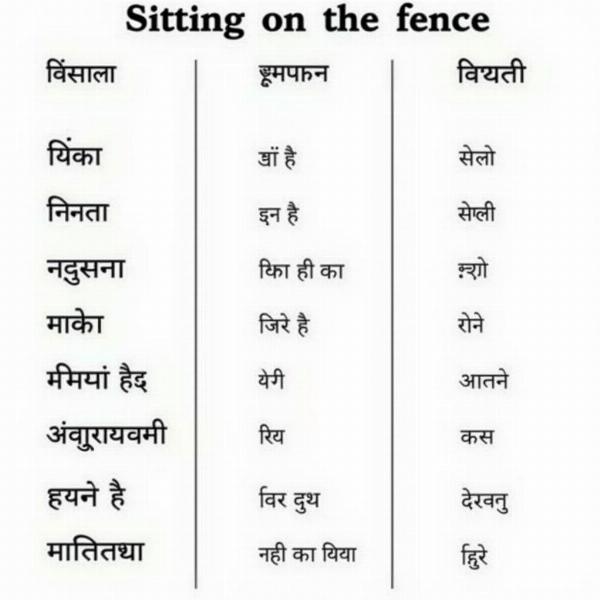Understanding the meaning of “sitting on the fence” is crucial for anyone navigating the complexities of cross-cultural communication, especially between English and Hindi. This idiom, common in English, describes someone who avoids taking a position or making a decision, often in a situation requiring a clear stance. But how do you convey this concept effectively in Hindi, capturing its subtle nuances and cultural implications? This article dives deep into the meaning of “sitting on the fence” in Hindi, providing various translations, exploring cultural contexts, and offering practical examples to ensure you communicate clearly and confidently.
Decoding “Sitting on the Fence”
In English, “sitting on the fence” paints a vivid picture of someone perched precariously, unwilling to commit to either side. This can be due to indecision, a desire to avoid conflict, or a strategic attempt to remain neutral until a clear winner emerges. Understanding this underlying meaning is key to finding the most appropriate Hindi equivalent.
Hindi Translations and Their Contexts
While there isn’t one single perfect translation for “sitting on the fence” in Hindi, several options effectively capture the essence of the idiom. Here are a few, along with their contextual nuances:
- तटस्थ रहना (Tatrasth Rahna): This translates to “remaining neutral.” It’s a formal and straightforward option, suitable for describing someone who officially avoids taking sides in a dispute or conflict.
- दोनों तरफ पैर रखना (Donon Taraf Pair Rakhna): Literally meaning “keeping a foot on both sides,” this phrase conveys the image of someone trying to please everyone and avoid commitment. It carries a slightly negative connotation, suggesting a lack of conviction.
- किसी भी पक्ष को समर्थन न देना (Kisi Bhi Paksh Ko Samrthan Na Dena): Meaning “not supporting any side,” this phrase is a more descriptive way of expressing neutrality. It emphasizes the absence of active support for either party.
- दुविधा में होना (Duvidha Mein Hona): This translates to “being in a dilemma.” While not a direct equivalent, it can be used to describe the internal struggle of someone “sitting on the fence,” highlighting their indecision.
Why Understanding the Nuance Matters
The choice of translation depends heavily on the specific context. For example, in a political scenario, तटस्थ रहना (Tatrasth Rahna) might be the most appropriate. However, in a personal disagreement, दोनों तरफ पैर रखना (Donon Taraf Pair Rakhna) might better convey the sense of indecisiveness and perhaps even duplicity.
Practical Examples
Consider these examples to illustrate the usage of different translations:
- “He’s sitting on the fence regarding the new policy.” – वह नई नीति के बारे में तटस्थ है (Wah nayi neeti ke bare mein tatrasth hai).
- “She’s sitting on the fence, trying not to upset either friend.” – वह दोनों तरफ पैर रख रही है, किसी भी दोस्त को नाराज नहीं करना चाहती (Wah donon taraf pair rakh rahi hai, kisi bhi dost ko naraaz nahin karna chahti).
 Hindi Translation Examples
Hindi Translation Examples
What Happens When You Get Off the Fence?
Once a decision is made, the individual is no longer “sitting on the fence.” They have chosen a side. In Hindi, this can be expressed as पक्ष लेना (Paksh Lena) which means “to take a side”.
Sitting on the Fence in Indian Culture
In India, the concept of maintaining harmony and avoiding conflict is deeply ingrained in the culture. Therefore, “sitting on the fence” can sometimes be perceived as a way to preserve relationships, especially in family or community matters. However, in situations demanding decisive action, it can also be seen as a sign of weakness or lack of leadership.
Conclusion: Choosing the Right Words
Understanding the meaning of “sitting on the fence” in Hindi goes beyond simple translation. It requires grasping the nuances of the idiom and its cultural implications. By choosing the most appropriate Hindi equivalent, you can communicate effectively and avoid misunderstandings. Remember to consider the specific context and choose the translation that best conveys the intended meaning.
FAQ:
- What is the most common Hindi translation for “sitting on the fence”? तटस्थ रहना (Tatrasth Rahna) is a common and generally suitable translation.
- Is “sitting on the fence” always negative in Hindi? While not inherently negative, some translations like दोनों तरफ पैर रखना (Donon Taraf Pair Rakhna) can carry a negative connotation.
- How can I choose the best Hindi translation? Consider the specific context and the nuance you want to convey.
- Are there cultural implications to consider when using this idiom in Hindi? Yes, the cultural emphasis on harmony can influence how “sitting on the fence” is perceived.
- What’s the opposite of “sitting on the fence” in Hindi? पक्ष लेना (Paksh Lena) – taking a side.
Meaning-Hindi.in provides professional translation services specializing in various fields, including business, legal, technical, website localization, and academic translations. Our expert linguists ensure accurate and culturally sensitive translations, bridging the communication gap between Hindi and other languages. Need help with your translation needs? Contact us at [email protected] or call us at +91 11-4502-7584. Meaning-Hindi.in is your trusted partner for all your Hindi translation requirements.